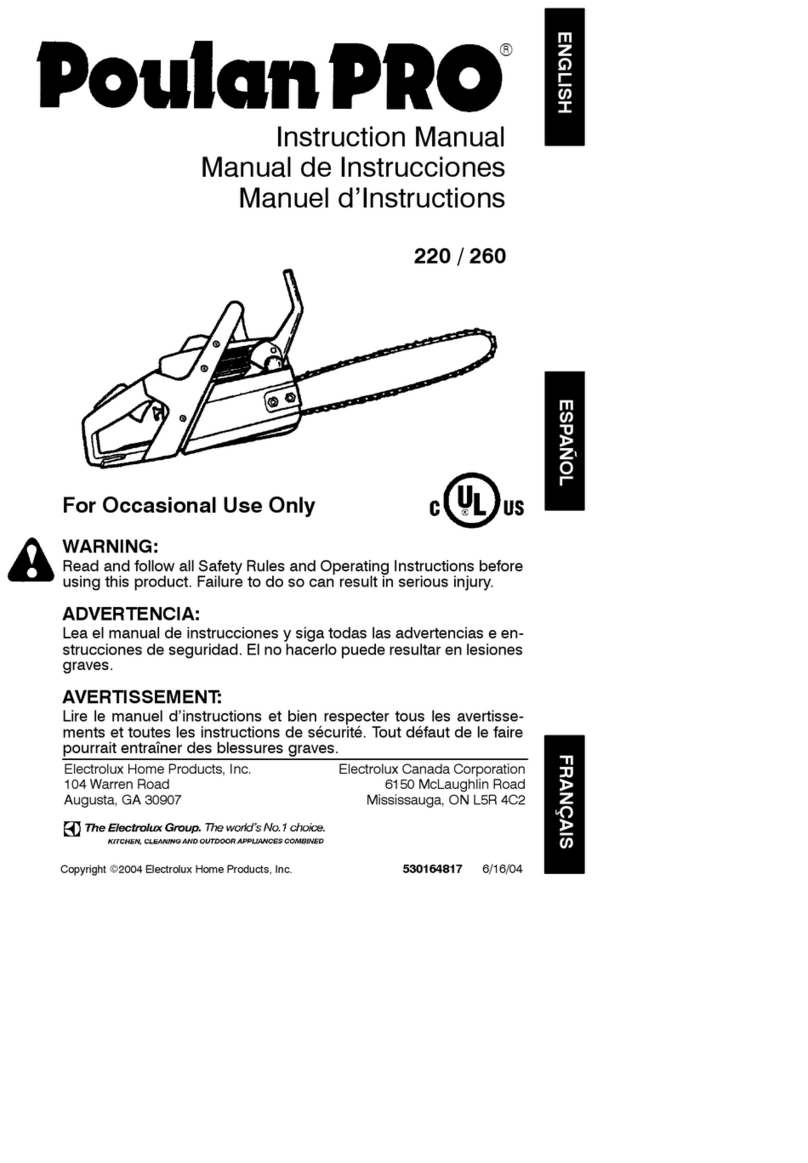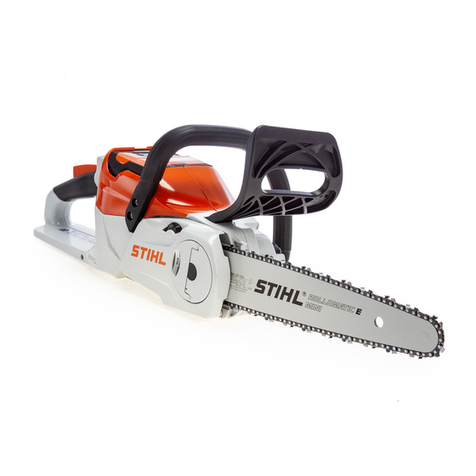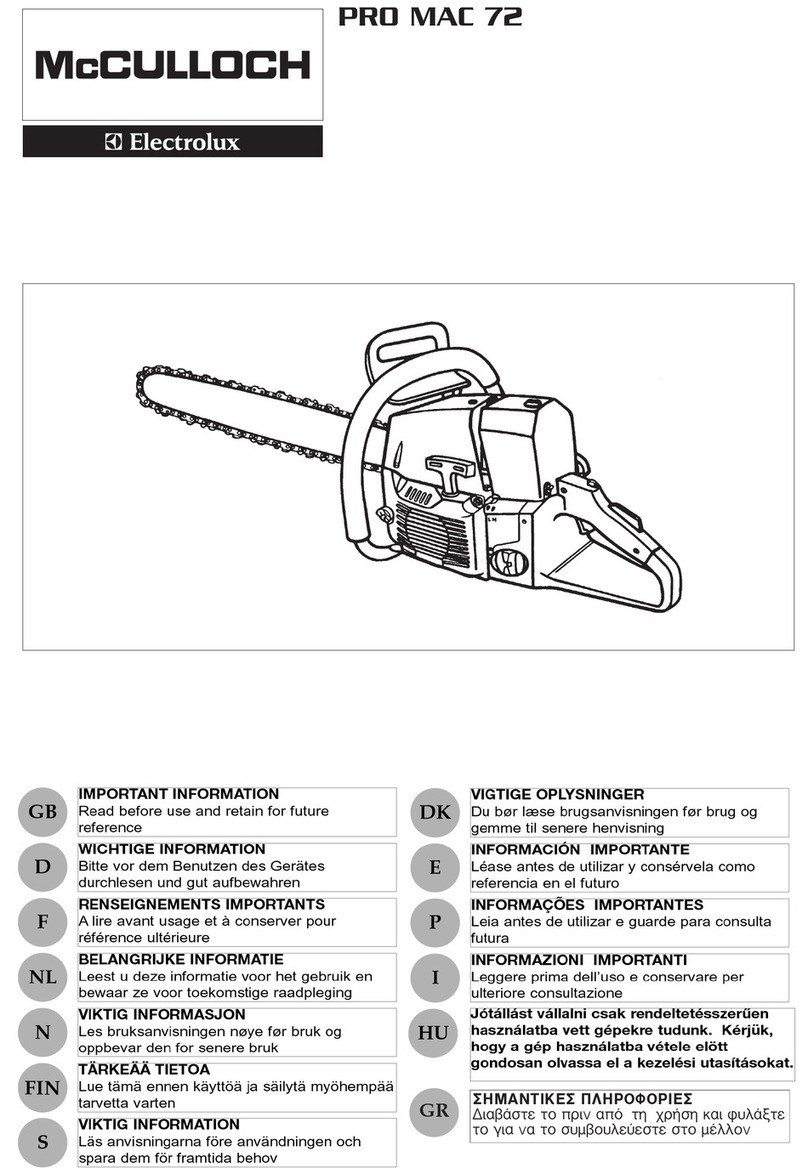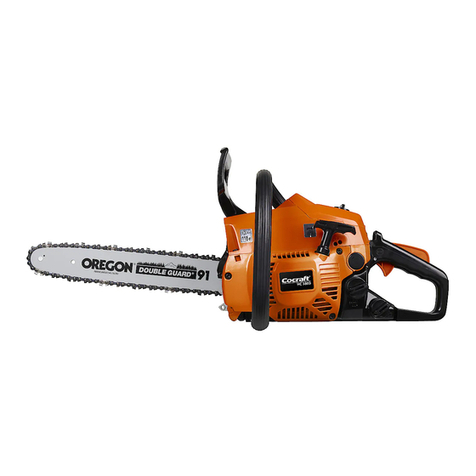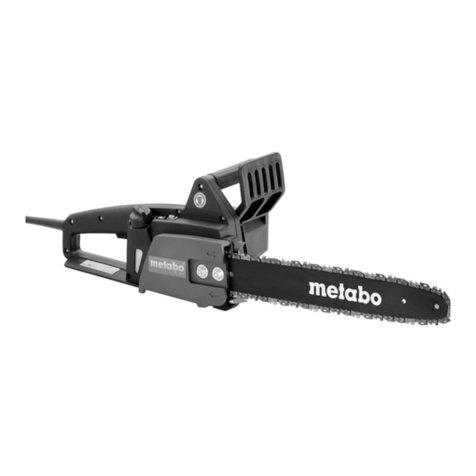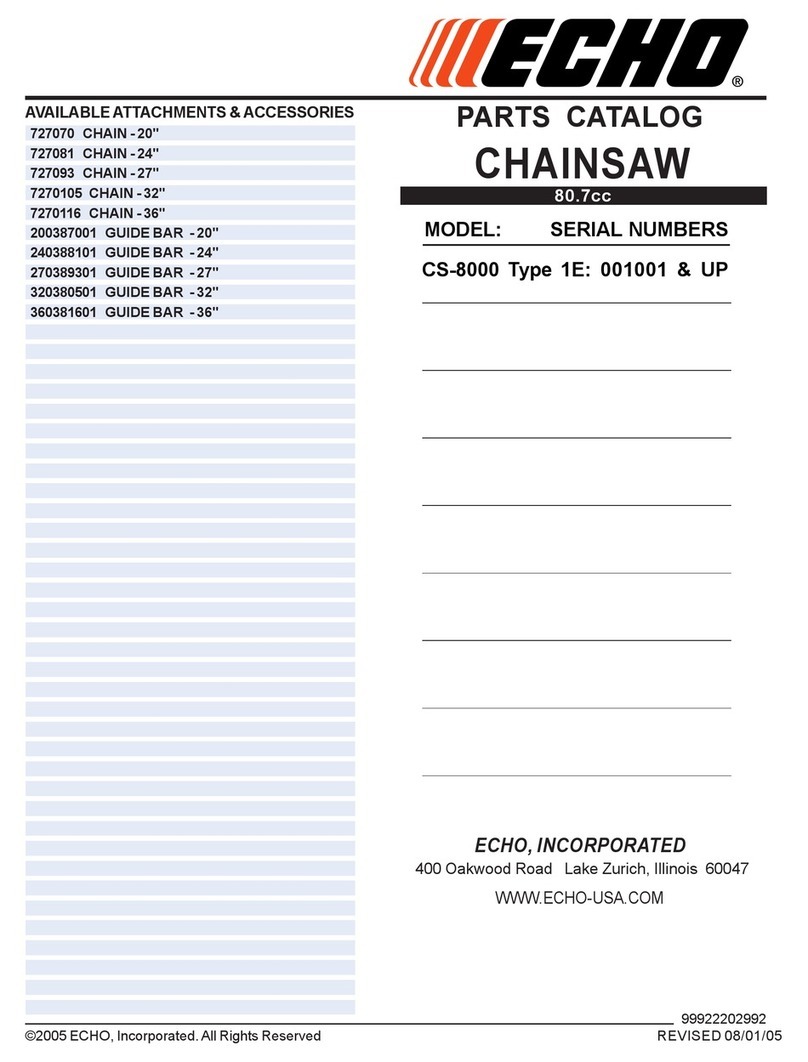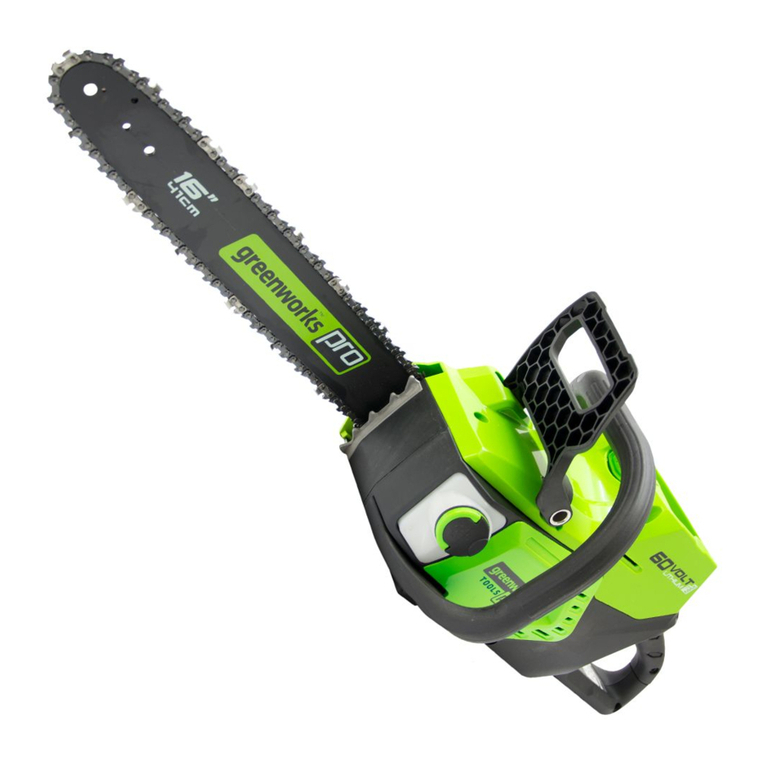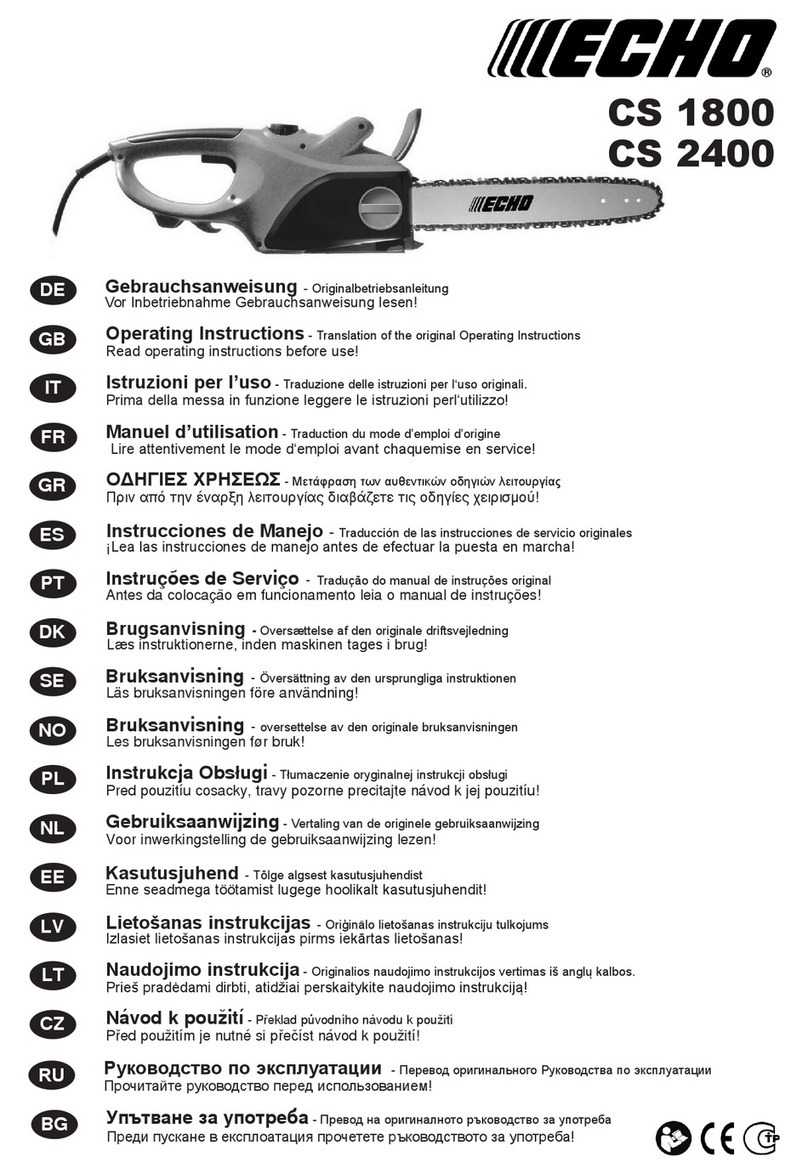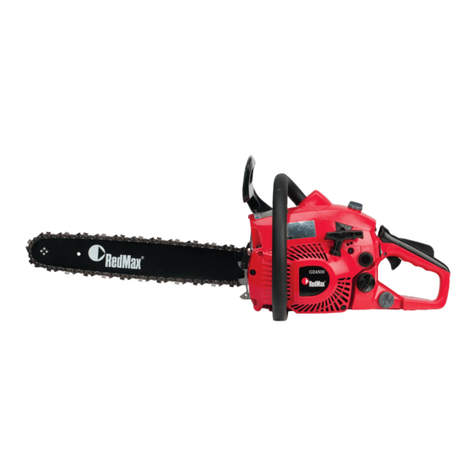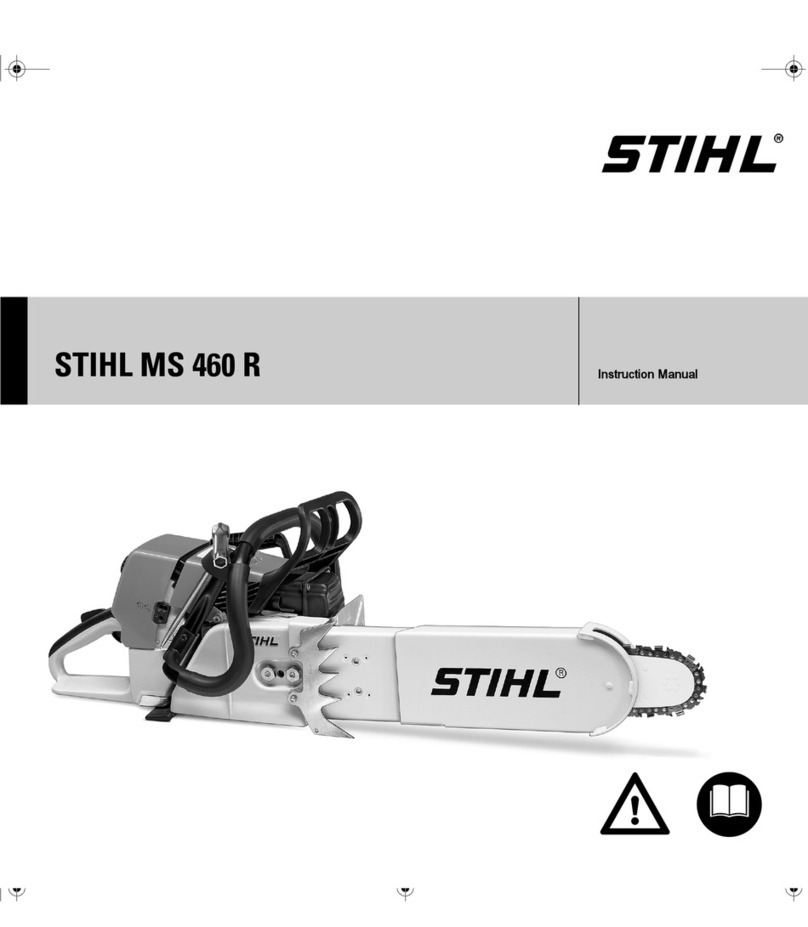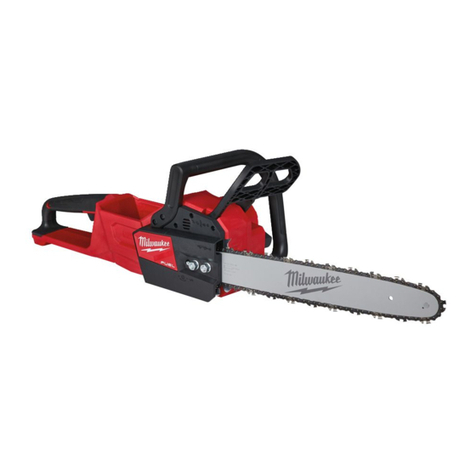Patriot 1900 User manual

Patriot l
Instruction Manual
Manual de Instrucciones
Manuel d'lnstructions
1900
AFor Occasional Use Only
WARNING:
Read and follow all Safety Rules and Operating Instructions before
using this product. Failure to do so can result in serious injury.
ADVERTENCIA:
Lea el manual de instrucciones y siga todas las advertencias e en-
strucciones de seguridad. El no hacerlo puede resultar en lesiones
graves.
AVERTISSEMENT:
Lire le manuel d'instructions et bien respecter tous les avertisse-
ments et toutes les instructions de s_curit_. Tout d_faut de le faire
pourrait entrafner des blessures graves.
Electrolux Home Products, Inc.
250 Bobby Jones Expressway
Augusta, GA 30907
[] From the ElectroluxGroup. The world's No,l choice,
KIt'CHF_,CLE,_NINGAN_)OUTDOOg,_ppIJAN_ESCOM_NBJ
Copyright/_)2002 Electrolux Home Products, Inc. 530088309 4/9/02

WARNING! This chain
saw can be dangerous! Care-
less or improper use can cause
sepeus or even fatal injury.
Read and understand the
instruction manual before
using the chain saw.
[_ Always wear appropriate ear protection, eye protection and head protection.
Always use two hands when operating the chain saw.
WARNING! Contacting the guide bar tip with any object
should be avoided; tip contact may cause the guide bar to
move suddenly upward and backward, which may cause se-
rious injury.
Measured maximum kickback value without chain brake for the bar
and chain combination on the label.
_WARNING: Always disconnect
spark plug wire and place wire where it can-
not contact spark plug to prevent accidental
starting when setting up, transporting, ad-
justing or making repairs except carburetor
adjustments.
Because a chain saw is a high-speed wood-
cutting tool, special safety precautions must
be observed to reduce the risk of accidents.
Careless or improper use of this tool can
cause serious injury.
PLAN AHEAD
•Read this manual carefully until you com-
pletely understand and can follow all safety
rules, precautions, and operating instruc-
tions before attempting to use the unit.
• Restrict the use of your saw to adult users
who understand and can follow safety
rules, precautions, and operating instruc-
tions found in this manual.
• Wear protective gear. Always use steel-
toed safety footwear with non-slip soles;
snug-fitting clothing; heavy-duty, non-slip
g!oves; eye protection such as non-fog-
gtng, vented goggles or face screen; an
approved safety hard hat; and sound barri-
ers ear plugs or mufflers to protect your
hear ng. Regular users should have hear-
ing checked regularly as chain saw noise
can damage hearing. Secure hair above
shoulder length.
Safety Safety Chaps
Shoes
2
• Keep all parts of your body away from the
chain when the engine is running.
• Keep children, bystanders, and animals a
minimum of 30 feet (10 meters) away from
the work area. Do not allow other people
or animals to be near the chain saw when
starting or operating the chain saw.
• Do not handle or operate a chain saw when
you are fatigued, ill, or upset, or if you have
taken alcohol, drugs, or medication. You
must be in good physical condition and men-
tally alert. Chain saw work is strenuous. If
you have any condition that might be aggra-
vated by strenuous work, check with your
doctor before operating a chain saw.

• Carefullyplanyoursawingoperationinad-
vance.Donotstartcuttinguntilyouhavea
clearworkarea,securefooting,and,ifyou
arefellingtrees,aplannedretreatpath.
OPERATE YOUR SAW SAFELY
• Do not operate a chain saw with one hand.
Serious injury to the operator, helpers, by-
standers or any combination of these per-
sons may result from one-handed opera-
tion. A chain saw is intended for
two-handed use.
• Operate the chain saw only in a well-venti-
lated outdoor area.
• Do not operate saw from a ladder or in a
tree.
• Make sure the chain will not make contact
with any object while starting the engine.
Never try to start the saw when the guide
bar is in a cut.
• Do not put pressure on the saw at the end
of the cut. Applying pressure can cause
you to lose control when the cut is com-
pleted.
• Stop the engine before setting the saw
down.
• Do not operate a chain saw that is dam-
aged, improperly adjusted, or not com-
pletely and securely assembled. Always
replace bar, chain, hand guard, or chain
brake immediately if it becomes damaged,
broken or is otherwise removed.
• With the engine stopped, hand carry the
chain saw with the muffler away from your
body, and the guide bar and chain to the
rear, preferably covered with a scabbard.
MAINTAIN YOUR SAW IN GOOD
WORKING ORDER
• Have all chain saw service performed by a
qualified service dealer with the exception
of the items listed in the maintenance sec-
tion of this manual. For example, if improp-
er tools are used to remove or hold the fly-
wheel when servicing the clutch, structural
damage to the flywheel can occur and
cause the flywheel to burst.
• Make certain the saw chain stops moving
when the throttle trigger is released. For
correction, refer to CARBURETOR AD-
JUSTMENTS.
Never modify your saw in any way.
• Keep the handles dry, clean, and free of oil
or fuel mixture.
• Keep fuel and oil caps, screws, and fas-
teners securely tightened.
• Use only Poulan® accessories and ra-
placement parts as recommended.
HANDLE FUEL WITH CAUTION
• Do not smoke while handling fuel or while
operating the saw.
• Eliminate all sources of sparks or flame in
the areas where fuel is mixed or poured.
There should be no smoking, open flames,
or workthat could cause sparks. Allow en-
gine to cool before refueling.
• Mix and pour fuel in an outdoor area on
bare ground; store fuel in a cool, dry, well
ventilated place; and use an approved,
marked container for all fuel purposes.
Wipe up all fuel spills before starting saw.
• Move at least 10feet 3 meters from fuel-
ngs te before start ng eng he.
• Turn the engine off and let saw cool in a
non-combustible area, not on dry leaves,
straw, paper, etc. Slowly remove fuel cap
and refuel unit.
• Store the unit and fuel in an area where fuel
vapors cannot reach sparks or open
flames from water heaters, electric motors
or switches, furnaces, etc.
KICKBACK
WARNING: Avoid kickback which
can result in serious injury. Kickback is the
backward, upward or sudden forward motion
of the guide bar occurring when the saw
chain near the upper tip of the guide bar con-
tacts any object such as a log or branch, or
when the wood closes in and pinches the
saw chain in the cut. Contacting a foreign ob-
ject in the wood can also result in loss of
chain saw control.
•Rotational Kickback can occur when the
moving chain contacts an object at the up-
per tip of the guide bar. This contact can
cause the chain to dig into the obect,
which stops the chain for an instant. The
result is a lightning fast, reverse reaction
which kicks the guide bar up and back to-
ward the operator.
•Pinch-Kickback can occur when the the
wood closes in and pinches the moving
saw chain in the cut along the top of the
guide bar and the saw chain is suddenly
stopped. This sudden stopping of the
chain results in a reversal of the chain
force used to cut wood and causes the
saw to move in the oppesite direction of the
chain rotation. The saw is driven straight
back toward the operator.
•Pull4n can occur when the moving chain
contacts a foreign object in the wood in the
cut along the bottom of the guide bar and the
saw chain is suddenly stopped. This sudden
stopping pulis the saw forward and away
from the operator and could easily cause the
operator to lose control of the saw.
Avoid Pinch-Kickback:
• Be extremely aware of situations or ob-
structions that can cause material to pinch
the top of or otherwise stop the chain.
• DO not cut more than one log at a time.
• Do not twist the saw as the bar is with-
drawn from an undercut when bucking.
Avoid Pull-in:
• Always begin cutting with the engine at full
speed and the saw housing against wood.
• Use wedges made of plastic or wood.
Never use metal to hold the cut open.
_i *_'_-_- Kickback Path
3

_ Avoid Obstructions
Clear The Working Area
REDUCE THE CHANCE OF
KICKBACK
•Recognize that kickback can happen.
With a basic understanding of kickback,
you can reduce the element of surprise
which contributes to accidents.
• Never let the moving chain contact any ob-
ect at the tip of the guide bar.
• Keep the working area free from obstruc-
tions such as other trees, branches, rocks,
fences, stumps, etc. Eliminate or avoid
any obstruction that your saw chain could
hit while you are cutting. When cutting a
branch, do not let the guide bar contact
branch or other ob ects around it.
• Keep your saw cha n sharp and properly
tensioned. A loose or dull chain can in-
crease the chance of kickback occurring.
Follow manufacturer's chain sharpening
and maintenance instructions. Checkten-
sion at regular intervals with the engine
stopped, never with the engine running.
Make sure the chain brake nuts are se-
curely tightened after tensioning the chain.
• Begin and continue cutting at full speed. If
the chain is moving at a slower speed,
there is greater chance of kickback occur-
ring.
• Cut one log at a time.
• Use extreme caution when re-entering a
previous cut.
• Do not attempt cuts starting with the tip of
the bar (plunge cuts).
• Watch for shifting logs or other forces that
could close a cut and pinch or fall into
chain,
• Use the Reduced-Kickback Guide Bar
and Low-Kickback Chain specified for
your saw.
MAINTAIN CONTROL
Stand to the
left of the saw
Never_
hand positions
_ Thumb on
underside of
handlebar
\
Elbow locked
Thumb on underside of
handlebar
• Keep a good, firm grip on the saw with both
hands when the engine is running and
don't let go. A firm grip will help you reduce
kickback and maintain control of the saw.
Keep the fingers of your left hand encir-
cling and your left thumb under the front
handlebar. Keep your right hand com-
pletely around the rear handle whether
your are right handed or left handed. Keep
your left arm straight with the elbow
locked.
• Position your left hand on the front handle-
bar so it is in a straight line with your right
hand on the rear handle when making
bucking cuts. Never reverse right and left
hand positions for any type of cutting.
• Stand with your weight evenly belanced on
both feet.
• Stand slightly to the left side of the saw to
keep your body from being in a direct line
with the cutting chain.
• Do not overreach. You could be drawn or
thrown off balance and lose control of the
SaW.
• Do not cut above shoulder height. _tis diffi-
cult to maintain control of saw above
shoulder height.
KICKBACK SAFETY FEATURES
i_ WARNING: Tbefollowingfeatures
are included on your sawto help reduce the
hazard of kickback; however, such features
will not totally eliminate this danger. As a
chain saw user, do not rely only on safety de-
vices. You must follow all safety precau-
tions, instructions, and maintenance in this
manual to help avoid kickback and other
forces which can result in serious in ury.
• Reduced-Kickback Guide Bar, des gned
with a small radius tip which reduces the
size of the kickback danger zone on the
bar tip. A Reduced-Kickback Guide Bar
has been demonstrated to significantly re-
duce the number and seriousness of kick-
backs when tested in accordance with
safety requirements for gasoline powered
chain saws as set by ANSI B175.1.
4

Reduced Kickback Symmetrical Guide Bar
aJl Radius Tip
Symmetdce3 Guide Bar_
[Large Radius Tip
• Low-Kickbeck Chain, designed with a
contoured depth gauge and guard link
which deflect kickback force and allow
wood to gradually ride into the cutter. Low-
Kickback Chain has met kickback per-
formance requirements when tested on a
representative sample of chain saws be-
low 3.8 cubic inch displacement specified
in ANSI B175.1.
Contoured Depth GaL_ge
_"_ [k Elongated Guard LinkDeflects
ickback force
Low-I_ckback and allows wood
Chain to gradually ride
into cutter
_L_C an Obstruct MatedeJ
Not a Low- KJckbaek Chain
• Front Hand Guard, designed to reduce the
chance of your left hand contacting the
chain if your hand slips off the front handle-
bar.
• Position of front and rear handlebars, de-
signed with distance between handles and
"in-line" with each other. The spread and
"in-line" position of the hands provided by
this design work together to give balance
and resistance in controlling the pivot of
the saw back toward the operator if kick-
back occurs.
CHAIN BRAKE AND CKA ANGLE
• Chain Brake, designed to stop the chain in
the event of kickback.
_WARNING: WE DO NOT REP-
RESENT AND YOU SHOULD NOT AS-
SUME THAT THE CHAIN BRAKE WILL
PROTECT YOU IN THE EVENT OF A
KICKBACK. Kickback is a lightning fast ac-
tion which throws the bar and rotating chain
back and up toward the operator. Kickback
Computed kickback angle (CKA lTable
BAR ,, /
MODEL P/N Length CHAIN P/N
1900 952044366 12 /952051208
can be caused by allowing contact of the bar
tip in the danger zone with any hard ob ect.
Kickback can also be caused by pinching the
saw chain along the top of the guide bar. This
action may push the guide bar rapidly back
toward the operator. Either of these events
may cause you to lose control of the saw
which could result in serious iniury or even
death. DO NOT RELY UPON ANY OF THE
DEVICES BUILT INTO YOUR SAW. YOU
SHOULD USE THE SAW PROPERLY AND
CAREFULLY TO AVOID KICKBACK. Re-
duced-kickback guide bars and low-kick-
back saw chains reduce the chance and
magnitude of kickback and are recom-
mended. Your saw has a low kickback chain
and bar as original equipment. Repairs on a
chain brake should be made by an autho-
rized servicing dealer. Take your unit to the
p!ane of purchase if purchased from a ser-
wcmg dealer, or to the nearest authorized
master service dealer.
• Tip contact in some cases may cause a light-
ning fast reverse REACTION, kicking guide
bar up and back toward operator.
• Pinching the saw chain along the top of the
guide bar may push the guide bar rapidly
back toward the operator.
• Either of these reactions may cause you to
lose control of the saw which could result in
serious injury. Do not rely exclusively upon
devices built into your saw.
,_ WARNING: Computed kickback
angle (CKA) listed on your saw and listed in the
CKA table below represents angle of kickback
your bar and chain combinations will have
when tested in accordance with CSA (Cana-
dian Standards Association) and ANSI stan-
dards. When purchasing replacement bar and
chain, considerations should be given to the
lower CKA values. Lower CKA values repre-
sent safer angles to the user, higher values in-
dicate more angle and higher kick energies.
Computed angles represented indicate total
energy and angle associated without activation
of the chain brake during kickback. Activated
angle represents chain stopping time relative to
activation angle of chain break and resulting
kick angle of saw. In all cases lower CKA val-
ues represent a safer operating environment
for the user.
The following guide bar and chain combina-
tions meet kickback requirements of CSA
Standards Z62.1, Z623, & ANSI B175.1
when used on saws listed in this manual.
Use of bar and chain combinations other
than those listed is not recommended and
may not meet the CKA requirements per
standard.
CKA without chain brake
4o
5

NOTE: If this saw is to be used for com-
mercial logging, a chain brake is required
and shall not be removed or otherwise dis-
abled to comply with Federal OSHA Regula-
tions for Commercial Logging.
SAFETY NOTICE: Exposure to vibrations
through prolonged use of gasoline powered
hand tools could cause blood vessel or nerve
damage in the fingers, hands, and oints of
people prone to circulation disorders or
abnormal swellings. Prolonged use in cold
weather has been linked to blood vessel
damage in otherwise healthy people. If
symptoms occur such as numbness, pain,
loss of strength, change in skin color or texture,
or loss of fooling in the fingers, hands, or joints,
discontinue the use of this tool and seek
medical attention. An anti-vibration system
does not guarantee the avoidance of these
problems. Users who operate power tools on
a continual and regular basis must monitor
closely their physical condition and the
condition of this tool.
SPECIAL NOTICE: Your saw is equipped
with a temperature limiting muffler and spark
arresting screen which meets the
requirements of California Cedes 4442 and
4443. All U.S. forest land and the states of
California, idaho, Maine, Minnesota, New
Jersey, Oregon, and Washington require by
law that many internal combustion engines
to be equipped with a spark arresting screen.
Ifyou operate a chain saw in a state or locale
where such regulations exist, you are legally
responsible for maintaining the operating
condition of these parts. Failure to do so is
a violation of the law. Refer to the SERVICE
section for maintenance of the spark
arresting screen.
Failure to follow all Safety Rules and Precau-
tions can result in serious in ury. If situations
occur which are not covered n th s manual,
use care and good udgement. If you need
assistance, contact your authorized service
dealer or call 1-800-554-6723.
STANDARDS: This saw is listed by Under-
writer's Laboratories, Inc., in accordance with:
ANSI B175.1-2000 American National
Standards for Gasoline-Powered Chain
Saws - Safety Requirements
CSA Z62.1-1995 Chain Saws - Occupa-
tional Health and Safety
CSA Z62.3-1996 Chain Saw Kickback Oc-
cupetional Health and Safety
Protective gloves (not provided) should be
worn during assembly.
ATTACHING THE BAR & CHAIN (if not
already attached)
_kWARNING: If received assembled,
repeat all steps to ensure your saw is properly
assembled and all fasteners are secure. Al-
ways wear gloves when handling the chain. 6
The chain is sharp and can cut you even when
it is not moving!
t. Loosen and remove the chain brake nuts
and the chain brake from the saw.
2. Remove the plastic shipping spacer (if
present). Location of shipping spacer
O
chainBak
Ch Nuts
Bar Tool
3 An adjusting pin and screw is used to ad-
just the tension of the chain. It is very im-
pertant when assembling the bar, that the
kin located on the adjusting screw aligns
to a hole in the bar. Turning the screw will
move the adjustment pin up and down the
screw. Locate this adjustment before you
begin mounting the bar onto the saw. See
illustration below.
_. ,_=_ Inside view of
hain Brake
Adjustment located on Chain Brake
4. Turn the adjusting screw by hand coun-
terolockwise until the adjusting pin just
touches the stop. This should allow the
pin to be near the correct position.
5. Slide guide bar behind clutch drum until
guide bar stops against clutch drum
sprocket.
6. Carefully remove the chain from the peck-
age. Hold chain with the drive links as
shown.
Tipr of
DIIBECTION OF ROTATION

Cutters DepthGauge
DriveLinks
Place chNn onto the sprocket
7, Place chain over and behind clutch, fit-
ting the drive links in the clutch drum
sprocket.
8. Fit bottom of drive links between the
teeth in the sprocket in the nose of the
guide bar.
9. Fit chain drive links into bar groove.
10. Pull guide bar forward until chain is snug
in guide bar groove. Ensure all drive
links are in the bar groove.
NOTE: CHAIN BRAKE MUST BE
DISENGAGED BEFORE INSTALLA-
TION ON THE SAW. TO DISENGAGE
CHAIN BRAKE, PULL THE FRONT
HAND GUARD BACK TOWARD THE
REAR OF THE CHAIN BRAKE AS
FAR AS POSSIBLE (SEE ILLUSTRA-
TION). DISENGAGED
Front Hand Guard
ENGAGED
Chain Brake
1t. Now, install chain brake making sure the
ad usting pin is positioned in the lower
hole n the gu de bar. Remember th s pin
moves the bar forward and backward as
the screw is turned.
12. Install chain brake nuts and finger tighten
only. Once the chain is tensioned, you
will need to tighten chain brake nuts.
CHAIN TENSION
(Including units with chain already installed)
NOTE: When ad usting chain tension,
make sure the cha n brake nuts are finger
tight only. Attempting to tension the chain
when the chain brake nuts are tight can
cause damage.
Checking the tension:
Use the screwdriver end of the chain adjust-
ment tool (bar tool) to move the chain around
the bar. If the chain does not rotate, it is too
tight. Iftoo loose, the chain will sag below the
ba£
Chain Brake Nuts Tool (Bar Tool)
Adjusting the tension:
Chain tension is very important, Chain
stretches during use, This is especially true
during the first few times you use your saw.
Always check chain tension each time you
use and refuel your saw.
You can adjust the chain tension by loosen-
ing the chain brake nuts and turning the ad-
justing screw 1/4 of aturn while lifting up on
the bar.
• Ifchain is tootight, turn ad usting screw 1/4
turn counterclockwise.
• If chain is too loose, turn adjusting screw
1/4 turn clockwise. / /
Screw /
Chain Brake Nuts Guide Bar
Adjusting Screw - 1/4 Turn
• Lift up the tip of the bar and securely tight-
en the chain brake nuts with the bar tool.
• Recheck chain tension.
Chain Brake
Nuts
WARNING: If the saw is operated
with a loose chain, the chain could jump off
the guide bar and result in serious injury.
7

KNOW YOUR CHAIN SAW
READ THIS INSTRUCTION MANUAL AND SAFETY RULES BEFORE OPERATING YOUR
CHAIN SAW, Compare the illustrations with your unit to familiarize yourself with the location of
the various controls and adjustments. Save this manual for future reference,
Chain Front Hand Guard --_
Adjustment Tool
(Bar Tool)
Muffler
Front Handle
Starter Rope
ON/STOP
I[/I Sw,tch
Primer
,=r/ /
Bar Oil Fill Cap Housing Fuel Mix Fill Cap
_ Chain
Adjusting _ _,. oDfi_-r(ti°l_
Chain Chain Nuts Sprocket
Brake Catcher Hole
Cylinder Cover
Fast Idle\
Throttle Lock
Lockout o
Throttle Choke
Trigger Knob
ON!STOP SWITCH
The ON/STOP SWITCH is used to stop the
engine.
THRO'rrLE TRIGGER
The THROTTLE TRIGGER controls engine
speed.
THRO'rrLE LOCK-OUT
The THROTTLE LOCK-OUT must be
pressed before you can squeeze the throttle
trigger. This feature prevents you from acci-
dentally squeezing the tngger.
FAST IDLE LOCK
The FAST IDLE LOCK holds the throttletrigger
in the starting .position. Activate the fast =die
lock by pressing the throttle lockout and
squeezing the throttle trigger. With the throttle
trigger squeezed, press the fast idle lock. Re-
lease the throttlelockout and tngger while hold-
ing the fast idle lock button.
CHOKE KNOB
The CHOKE KNOB activates the choke to
provide additional fuel to the engine during cold
stading.
PRIMER BULB
The PRIMER BULB circulatesfuel to the car-
buretor to provide quicker stading.
CHAIN BRAKE
The CHAIN BRAKE is a device designed to
stop the chain if kickback occurs, The chain
brake activates automatically in the event of
kickback, The chain brake activates manually
if the front hand guard is pushed fonNard. The
chain brake is disengaged by pulling the front
hand guard back toward the front handle as far
as possible,
CHAIN TENSION
Itis normal fora newchain to stretch duringfirst
30 minL_es of operation. YOU should check
your chain tension frequently. See CHAIN
TENSION under the ASSEMBLY section,
_WARNING: Muffler isvery hotdur-
ing and after use. Do not touch the muffler or
allow combustible material such as dry
grass or fuel to do so,
8

WARNING: Remove fuelcaps_o wl
ly when refueling.
FUELING ENGINE
This engine is certified to operate on un-
leaded gasoline. Before operation, gasoline
must be mixed with a good quality synthetic
2-cycle air-cooled engine oil designed to be
mixed at a ratio of 40:1. Poulan/Weed Eater
brand synthetic oil is recommended, Mix
gasoline and oil at a ratio of 40:1, A 40:1 ratio
_sobtained by mixing 3.2 ounces of oil with 1
gallon of unleaded gasoline. Included with
this saw is a 3,2 ounce container of oil. Pour
the entire contents of this container into 1
gallon of gasoline to achieve the proper fuel
mixture,
DO NOT USE automotive oil or boat oil. These
oils will cause engine damage, When mixing
fuel, follow instnJctions printed on container.
Once oil is added to gasoline, shake container
momentarily to assure that the fuel is thorough-
ly mixed. Always read and follow the safety
rules relating to fuel before fueling your unit.
BAR AND CHAIN LUBRICATION
The bar and chain require continuous lubri-
cation. Lubrication is provided by the auto-
matic oiler system when the oil tank is kept
filled. Lack of oil will quickly ruin the bar and
chain, Too little oil will cause overheating
shown by smoke coming from the chain and/
or discoloration of the bar,
In freezing weather oil will thicken, making it
necessary to thin bar and chain oil with a
small amount (5 to t 0%) of #1 Diesel Fuel or
kerosene. Bar and chain oil must be free
flowing for the oil system to pump enough oil
for adequate lubrication.
Genuine Poulan ® bar and chain oil is recom-
mended to protect your unit against exces-
sive wear from heat and friction. Poulan ®
oil resists high temperature thinning. If Pou-
lan® bar and chain oil is not available, use a
good grade SAE 30 oil,
• Never use waste oil for bar and chain lubri-
cation.
• Always stop the engine before removing
the oil cap,
IMPORTANT
Experience indicates that alcohol-blended
fuels called gasohol or using ethanol or
methanol) can attract mo sture wh ch leads
to separation and formation of acids during
storage, Acidic gas can damage the fuel
system of an engine while in storage, To
avoid engine problems, the fuel system
should be emptied before storage for 30
days or longer. Drain the gas tank, start the
engine and let it run until the fuel lines and
carburetor are empty, Use fresh fuel next
season. See STORAGE section for addi-
tional information.
_WARNING: The chain must not
move when the engine runs at idle speed, If
the chain moves at idle speed refer to CAR-
BURETOR ADJUSTMENT within this
manual, Avoid contact with the muffler, A hot
muffler can cause serious burns.
To stop the engine move the ON/STOP
switch to the STOP position,
To start the engine hold the saw firmly on
the ground as illustrated. Make sure the
chain is free to turn without contacting any
object.
Use only t5"-18" of rope per pull.
Hold saw firmly while pulling starter rope
Starter rope handle
! Left hand
on front
handle
Right foot through rear handle
IMPORTANT POINTS TO REMEMBER
When pulling the starter rope, do not use the
full extent otthe rope as this can cause the
rope to break. Do not let starter rope snap
back. Hold the handle and let the rope re-
wind slowly.
NOTE: Do not attempt to cut material with
the fast idle lock button in the locked position.
STARTING A COLD ENGINE (or
warm engine after running out of
fuel) ON/STOP SWITCH
(SIDE VIEW)
ON
STOP
1. Move ON/STOP switch to the ON posi-
tion,
2. Pull choke knob out to the full extent,
3. Slowly press primer bulb 6 times,
4. Squeeze and hold throttle trigger, With
thumb press fast idle lock down; then re-
lease throttle trigger.
Fast idle lock button__[_
Throttle _
Iock-ou
Throt tle_______C be ke knob
trigger
5. Sharply pull the starter rope handle 5
times w=th your right hand, Then, pro-
ceed to the next step.
9

NOTE: If the engine sounds as if it is try-
ing to start before the 5th pull, stop pulling
and immediately proceed to the next step.
6. Push the choke knob in completely (to
the OFF position); pull the starter rope
until the engine starts.
CHOKE
IEW)
k
Choke knob OFF FULL
7. Allow the engine to run for approximately
5 seconds. Then, squeeze and release
throttle trigger to allow engine to return to
idle speed.
STARTING A WARM ENGINE:
1. Move ON/STOP switch to the ON posi-
tion.
2. Push the choke knob in completely (to
the OFF position).
3. Slowly press primer bulb 6 times.
4. Squeeze and hold throttle trigger. With
thumb press fast idle lock down; then re-
lease throttle trigger.
5. Sharply pull the starter rope with your
right hand until the engine starts.
6. Squeeze and release throttle trigger to
allow engine to return to idle speed.
DIFFICULT STARTING (or starting a
flooded engine):
The engine may be flooded with too much
fuel if it has not started after 10 palls.
Flooded engines can be cleared of excess
fuel by following the warm engine starting
procedure listed above. Insure the ON/
STOP switch is in the ON position.
Starting could require pulling the starter rope
handle many times depending on how badly
the unit is flooded. If engine fails to start, refer
to the TROUBLESHOOTING TABLE or call
1-800-554-6723.
CHAIN BRAKE
WARNING: If the brake band of tbe
chain brake is worn too thin it may break
when the chain brake is triggered. With a
broken brake band, the chain brake will not
stop the chain. The chain brake should be re-
placed by an authorized service dealer if any
part is worn to less than 0.020" (0.5 mm)
thick. Repairs on a chain brake should be
made by an authorized service dealer. Take
your unit to the place of purchase if pur-
chased from a servicing dealer, or to the
nearest authorized master service dealer.
• This saw is equipped with a chain brake.
The brake is designed to stop the chain if
kickback occurs.
• The inertia-activated chain brake is
activated if the front hand guard is pushed
forward, either manually (by hand) or
automatically by sudden movement.
• If the brake is already activated, it is
disengaged by pullingthe front hand guard
back toward the front handle as far as
possible.
• When cutting with the saw, the chain brake
must be disengaged.
Disengaged _
Engaged
Braking function control
CAUTION: The chain brake must be
checked several times daily. The engine
must be running when performing this proce-
dure. This is the only instance when the saw
should be placed on the ground with the en-
gine running.
Place the saw on firm ground. Grip the rear
handle with your right hand and the front han-
dle with your left hand. Apply full throttle by
fully depressing the throttle trigger. Activate
the chain brake by turning your left wrist
against the hand guard without releasing
your grip around the front handle. The chain
should stop immediately.
Inertia activating function control
4_JkWARNING: Whenperformingthe
following procedure, the engine must be
turned off.
Grip the rear handle with your right hand and
the front handle with your left hand. Hold the
chain saw approximately 14" (35 cm) above
a stump or other wooden surface. Release
your grip on the front handle and use the
weight of the saw to let the top of the guide
bar fall forward and contact the stump.
When the tip of the bar hits the stump, the
brake should activate.
IMPORTANT POINTS
• Check chain tension before first use and
after t minute of operation. See CHAIN
TENSION in the ASSEMBLY section.
• Cut wood only. Do not cut metal, plastics,
masonry, non-wood building materials, etc.
• Stop the saw if the chain strikes a foreign
object. Inspect the saw and repair or re-
place parts as necessary.
• Keep the chain out of dirt and sand. Even a
small amount of dirt will quickly dull a chain
and thus increase the possibility of kickback.
• Practice cutting afew small logs using the
following techniques to get the '#eel" of us-
ing your saw before you begin a major
sawing operation.
Squeeze the throttle trigger and allow
the engine to reach full speed before
cutting,
Begin cutting with the saw frame
against the log.
Keep the engine at full speed the en-
tire time you are cutting,
lO

Allow the chain to cut for you. Exert
only light downward pressure. If you
force the cut, damage to the bar,
chain, or engine can result.
Release the throttle trigger as soon as
the cut is completed, allowing the en-
gine to idle. If you run the saw at full
throttle without a cutting load, unnec-
essary wear can occur to the chain,
bar, and engine.
To avoid losing control when cut is
complete, do not put pressure on saw
at end of cut.
• Stop the engine before setting the saw
down after cutting.
TREE FELLING TECHNIQUES
_WARNING: Check for broken or
dead branches which can fall while cutting
causing serious in ury. Do not cut near build-
ings or electrical wires if you do not know the
direction of tree fall, nor cut at night since you
will not be ale to see well, nor during bad
weather such as rain, snow, or strong winds,
etc. If the tree makes contact with any utility
line, the utility company should be notified
immediately.
• Carefully plan your sawing operation in ad-
vance.
• Clear the work area. You need a clear area
all around the tree so you can have secure
footing.
• The chain saw operator should keep on
the uphill side of the terrain as the tree is
likely to roll or slide downhill after it is felled.
• Study the natural conditions that can cause
the tree to fall in a padicular direction.
Natural conditions that can cause a tree to
fall in a particular direction include:
• The wind direction and speed.
• The lean of the tree. The lean of a tree
might not be apparent due to uneven or
sloping terrain. Use a plumb or level to de-
termine the direction of tree lean.
Weight and branches on one side.
_ Surrounding trees and obstacles.
Look for decay and rot If the trunk is rotted,
it can snap and fall toward the operator.
Check for broken or dead branches which
can fall on you while cutting.
Make sure there is enough room for the tree to
fall. Maintain a distance of 2-1/2tree lengths
from the nearest person or otber objects. En-
gine noise can drown out a warning call.
Remove dirt, stones, loose bark, nails, sta-
ples, and wire from the tree where cuts are to
be made.
Plan a clear retreat path to the rear and diag-
onal to the line of fall.
_,_, Plan a clear retreat path
.... O''"_- Direction of Fall
FELLING LARGE TREES
(6 inches in diameter or larger)
The notch method is used to fell large trees.
A notch is cut on the side of the tree in the de-
sired direction of fall. After a felling cut is
made on the opposite side of tree, the tree
will tend to fall into the notch.
NOTE: If the tree has large buttress
roots, remove them before making the
notch. If using saw to remove buttress
roots, keep saw chain from contacting
ground to prevent dulling of the chain.
NOTCH CUT AND FELLING THE
TREE
•Make notch cut by cutting the top of the
notch first. Cut through 1/3of the diameter
of the tree. Next complete the notch by cut-
ting the bottom of the notch. See illustra-
tion. Once the notch is cut remove the
notch of wood from the tree.
Final (felling) cut here. 2 in-
ches above center of notch.
Firstcut,,,,',"i
Notch _ _._..
7
2,,
"_inge
• After removing the wood from the notch,
make the felling cut on the opposite side of
the notch. This isdone by making a cut about
two inches higher than the center of the
notch. This will leave enough uncut wood
between the felling cut and the notch to form
a hinge. This hinge will help prevent the tree
from falling in the wrong direction.
Hinge holds tree on stump and helps
control fall Opening
of felling
cut
Closing of
notch
NOTE: Before felling cut is complete, use
wedges to open the cut if necessary to
control the direction of fall. To avoid kickback
and chain damage, use wood or plastic
wedges, but never steel or iron wedges.
• Be alert to signs that the tree is ready to
fall: cracking sounds, widening of the fell-
ing cut, or movement in the upper
branches.
• As tree starts to fall, stop saw, put it down,
and get away quickly on your planned ra-
treat path.
11

• DONOTcutdownapartiallyfallentree
withyoursaw.Beextremelycautiouswith
partiallyfallentreesthatmaybepoorly
supported.Whenatreedoesn'tfallcom-
pletely,setthesawasideandpulldownthe
treewithacablewinch,blockandtackle,
ortractor.
CUTTING A FALLEN TREE
(BUCKING)
Bucking is the term used for cutting a fallen
tree to the desired log size.
WARNING: Do not stand on the log
being cut. Any portion can roll causing loss
of footing and control. Do not stand downhill
of the log being cut.
IMPORTANT POINTS
• Cut only one log at a time.
• Cut shattered wood very carefully; sharp
pieces of wood coold be flung toward oper-
ator.
• Use a sawhorse to cut small logs. Never
allow another person to hold the log while
cutting and never hold the log with your leg
or foot.
• Do not cut in an area where logs, limbs,
and roots are tangled such as in a blown
down area. Drag the logs into a clear area
before cutting by pulling out exposed and
cleared logs first.
TYPES OF CUTTING USED FOR
BUCKING
_kWARNING: If saw becomes
pinched or hung in a log, don't try to force it
out. You can lose control of the saw resulting
in injury and/or damage to the saw. Stop the
saw, drive a wedge of plastic or wood into the
cut until the saw can be removed easily. Re-
start the saw and carefully reenter the cut. To
avoid kickbeck and chain damage, do not
use a metal wedge. Do not attempt to restart
your saw when it is pinched or hung in a log.
Use a wedge to remove pinched saw
Turn saw OFF and use a plastic or
wooden wedge to force cut open,
Overcutting begins on the top side of the log
with the bottom of the saw against the log.
When overcutting use light downward pres-
sure,
_TvercutUng
Undercutting involves cutting on the under-
side of the log with top of saw against the log.
When undercutting use light upward pres-
sure. Hold saw firmly and maintain control.
The saw will tend to push back toward you.
_WARNING: Never turn saw upside
down to undercut. The saw cannot be con-
trolled in this position.
Always make your first cut on the compres-
sion side of the log. The compression side of
the log is where the pressure of the log's
weight is concentrated.
First cut on co_ression side of log
Second cut
Second cut
First cut on compression side of log
BUCKING WITHOUT A SUPPORT
• Overcut through 1/3of the diameter of the
log.
•Roll the log over end finish with e second
overcut.
• Watch for logs with a compression side to
prevent the saw from pinching. See il-
lustrations for cutting logs with a compres-
sion side.
BUCKING USING ALOG OR
SUPPORT STAND
• Remember your first cut is always on the
compression side of the log.
(Refer to the illustrations below for your
first and second cut)
• Your first cut should extend 1/3 of the
diameter of the log.
• Finish with your second cut.
Using a log for support
2nd
12

Using a support stand
2ndCut
1st Cut
t st Cut
LIMBING AND PRUNING
_WARNING: Be alert for and guard
against kickback. Do not allow the moving
chain to contact any other branches or ob-
iects at the nose of the guide bar when limb-
ing or pruning. A!lowing such contact can re-
sult m senous _nlury.
_kWARNING: Never climbinto atree
to limb or prune. Do not stand on ladders,
platforms, a log, or in any position which can
cause you to lose your balance or control of
the saw.
IMPORTANT POINTS
• Work slowly, keeping both hands firmly
gripped on the saw. Maintain secure foot-
mg and balance.
• Watch OL_for springpales. Springboles are
small size limbs which can catch the saw
chain and whip toward you or pull you off bal-
ance. Use extreme caution when cutting
small size limbs or slender material.
• Be alert for springback. Watch out for
branches that are bent or under pressure.
Avoid being struck by the branch or the
saw when the tension in the wood fibers is
released.
• Keep a clear work area. Frequently clear
branches out of the way to avoid tripping
over them.
LIMBING
• Always limb a tree after it is cut down. Only
then can limbing be done safely and prop-
erly.
• Leave the larger limbs underneath the
felled tree to support the tree as you work.
• Start at the base of the felled tree and work
toward the top, cutting branches and
limbs. Remove small limbs with one cut.
• Keep the tree between you and the chain.
Cut from the side of the tree opposite the
branch you are cutting.
• Remove larger, supporting branches with
the cutting techniques described in BUCK-
ING WITHOUT A SUPPORT.
• Always use an overcut to cut small and
freely hanging limbs. Undercutting could
cause limbs to fall and pinch the saw.
PRUNING
WARNING: Limit pruning to limbs
shoulder height or below. Do not cut if
branches are higher than your shoulder. Get
a professional to do the job.
Make your first cut 1/3 of the way
through the bottom of the limb.
Next make a 2nd cut all the way
through the limb. Then cut a third
overcut leaving a t to 2 inch collar
from the truck of the tree.
_Thi_r_dic Second cut'S"//
Collar tit_
_1_ _ First cut
t/ Pruning technique
WARNING: Disconnect the spark
plug before performing maintenance except
for carburetor adjustments.
We recommend all service and adjustments
not listed in this manual be performed by an
authorized or Master Service Dealer.
MAINTENANCE SCHEDULE
Lubricate bar
sprocket hole ....... After each use
Check:
Fuel mixture level ,.
Bar lubrication .....
Chain tension .....
Chain sharpness ,.
For damaged parts
For loose caps ....
For loose fasteners.
For loose parts ....
Inspect and Clean:
Bar ................ Before each use
Complete saw ..... After each use
Air filter ........... Every 5 hours*
Chain brake ........ Every 5 hours*
Spark arresting screen
and muffler ......... Every 25 hours*
Replace spark plug , Yearly
Replace fuel filter,., Yearly
* Hours of Operation
Before each use
Before each use
Before each use
Before each use
Before each use
Before each use
Before each use
Before each use
AIR FILTER
CAUTION: Do not clean filter in gasoline
or other flammable solvent to avoid creating
afire hazard or producing harmful evapora-
tive emissions.
Cleaning the air filter:
Adirty air filter decreases engine perform-
ance and increases fuel consumption and
13

harmful emissions. Always clean after 15
tanks of fuel or 5 hours of operation, which-
ever comes first. Clean more frequently in
dusty conditions. A used aire filter can never
be completely cleaned, g is advisable to re-
place your air filter with a new one after every
50 hours of operation, or annually, whichever
comes first.
1. Loosen 3 screws on cylinder cover.
2. Remove cylinder cover.
3. Remove air filter.
4. Clean the air filter using hot soapy water.
Rinse with clean cool water. Air dry com-
pletely before reinstalling.
5. Lightly oil air filter before installing to im-
prove the efficiency of air filter. Use
2-cycle engine oil or motor oil (SAE 30).
Squeeze excess oil from filter.
6. Reinstall air filter.
7. Reinstall cylinder cover and 3 screws.
Tighten securely.
....">_=.*--- Cy nder Cover
Air Filter f_'_-J Screws
INSPECT MUFFLER AND SPARK
ARRESTING SCREEN
As the unit is used, carbon deposits build up
on the muffler and spark arresting screen,
and must be removed to avoid creating afire
hazard or affecting engine performance.
Replace the spark arresting screen if breaks
occur.
_ jMuffler Diffuser
Spark
_lr._/" f_'jj y | Arresting
7" ,_ IlrfA /_ _/ScreenMuffler
_IXYOL_/// Cover
Y Cover
CLEANING THE SPARK ARREST-
ING SCREEN
Cleaning is required every 25 hours of op-
eration or annually, whichever comes first.
1. Loosen and remove the 2 muffler cover
screws.
2. Remove the muffler cover (cover snaps
off muffler body).
3. Remove muffler diffuser and spark ar-
resting screen assembly. Notice the
orientation of these parts for reassem-
bling.
4. Clean the spark arresting screen with a
wire brush. Replace screen if breaks are
found.
5. Replace any broken or cracked muffler
parts.
6. Reinstall diffuser and spark arresting
screen assembly with round holes facing
up.
7. Reinstall muffler cover and 2 screws.
Tighten securely.
CARBURETOR ADJUSTMENTS
Your carburetor is equipped with limiter
caps. Carburetor adjustment is a compli-
cated task. We recommend that you take
your unit to an authorized service dealer.
Damage will occur if you turn the needles be-
yond the limiter stops.
BAR MAINTENANCE
If your saw cuts to one side, has to be forced
through the cut, or been run with an improper
amount of bar lubrication it may be neces-
sary to service your bar. Aworn bar will dam-
age your chain and make cutting difficult.
After each use, ensure ON/STOP switch is
inthe STOP position, then clean ell sawdust
from the guide bar and sprocket hole.
To maintain guide bar:
•Move ON/STOP switch to the STOP posi-
tion.
• Loosen and remove chain brake nuts and
chain brake. Remove ber and chain from
SaW.
• Clean the oil holes and bar groove after
each 5 hours of operation.
Remove Sawdust From _
Guide Bar _oo_
O,He,es . o"
• Burring of guide bar rails is a normal
process of rail wear. Remove these burrs
with a flat file.
• When rail top is uneven, use a flat file to re-
store square edges and sides.
r__ File Rail Edges_b N N
and Sides I U
Square I I
Worn Groove Correct Groove
Replace guide bar when the groove is worn,
the guide bar is bent or cracked, or when
excess heating or burring of the rails occurs.
If replacement _s necessary, use only the
guide bar specified for your saw in the repair
parts list or on the decal located on the chain
SaW.
CHAIN SHARPENING
Chain sharpening is a complicated task that
requires special tools. We recommended
you refer chain sharpening to a professional
chain sharpener.
IGNITION TIMING
Ignition timing is fixed and nonadjustable.
SPARK PLUG
The spark plug should be replaced each
year to ensure the engine starts easier and
runs better.
14

1, Loosen 3 screws on cylinder cover,
2, Remove the cylinder cover.
3. Pull offthe spark plug booL
4, Remove spark plug from cylinder and
discard.
5, Replace with Champion RCJ-7Y spark
plug and tighten securely with a 3/4 inch
socket wrench, Spark plug gap should
be 0.025 inches,
6, Reinstall the spark plug booL
7, Reinstall the cylinder cover and 3
screws. Tighten securely.
Screws,,,,,,, t// _/_nder
STORAGE
_WARNING: Stopengine and allow
to cool, end secure the unit before storing or
transporting in a vehicle. Store unit end fuel
in an area where fuel vapors cannot reach
sparks or open flames from water heaters,
electric motors or switches, furnaces, etc.
Store unit with all guards in place. Position so
that any sharp obect cannot accidentally
cause in ury to passersby. Store the unit out
of reach of ch Idren.
•Before storing, drain all fuel from the unit.
Start engine and allow to run until it stops.
• Clean the unit before storing. Pay particu-
lar attention to the air intake area, keeping
it free of debris. Use a mild detergent and
sponge to clean the plastic surfaces.
• Do not store the unit or fuel in a closed area
where fuel vapors can reach sparks or an
open flame from hot water heaters, electric
motors or switches, furnaces, etc.
• Store in a dry area out of the reach of chil-
dren.
CAUTION: It is important to prevent gum
deposits from forming in essential fuel system
parts such as the carburetor, fuel filter, fuel
hose, or fuel tank during storage. Alcohol
blended fuels called gasohol or using ethanol
or methanol) can attract mo sture which leads
to fuel mixture separation and formation of
acids during storage. Acidic gas can damage
the engine.
TROUBLESHOOTING TABLE
_ WARNING: Always stop unit and disconnect spark plug before performing all of
the recommended remedies below except remedies that require operation of the unit.
TROUBLE CAUSE REMEDY
Engine will not 1. Ignition switch off. t. Move ignition switch to ON.
start or will run 2. Engine flooded, 2. See "Difficult Starting" in
only a few Operation Section.
seconds after 3. Fuel tank empty. 3. Fill tank with correct fuel mixture,
starting. 3. Spark plug not firing. 4. Install new spark plug.
4. Fuel not reaching 5. Check for dirty fuel filter; replace,
carburetor. Check for kinked or split fuel line;
repair or replace,
Engine will 1, Carburetor requires 1. Contact an authorized service dealer,
not idle adjustment
properly. 2, Crankshaft seals worn. 2. Contact an authorized service dealer,
Engine will not 1, Air filter dirty, t. Clean or replace air filter,
accelerate, 2, Spark plug fouled. 2. Clean or replace plug and regap.
lacks power, 3, Chain brake engaged. 3. Disengage chain brake,
or dies under 4, Carburetor requires 4. Contact an authorized service dealer.
a load, adjustment.
Engine f. Too much oil mixed with f. Empty fuel tank and refill with
smokes gasoline, correct fuel mixture.
excessively.
15

NEED ASSISTANCE?
Call 1-800-554-6723,
NEED SERVICE PART?
Contact your dealer or place of purchase.
ELECTROLUX HOME PRODUCTS, INC,
warrants to the original purchaser that each
new Patriot brand gasoline chain saw is free
from defects in material and workmanship
and agrees to repair or replace under this
warranty any defective gasoline chain saw
as follows from the original date of purchase.
1 YEAR - Parts and Labor, when used for
Household purposes.
60 DAYS -Parts and Labor, when used for
Commercial, Professional, or Income Pro-
ducing purposes.
30 DAYS - Parts and Labor, if used for rental
purposes.
This warranty is not transferable and does
not cover damage or liability caused by im-
proper handling, improper maintenance, or
the use of accessories and/or attachments
not specifically recommended by ELEC-
TROLUX HOME PRODUCTS, INC., for this
chain saw. Additionally, this warranty does
not cover damage caused by improper han-
dling, improper maintenance, or if the saw is
altered m any way which in our judgement af-
fects its condition or operation. This warranty
does not cover tune-up, spark plugs, filters,
starter ropes, starter springs, chain sharpen-
ing, bars, chains, and other parts which wear
and require replacement with reasonable
use during the warranty period. This warran-
ty does not cover predelivery set-up, instal-
lation of guide bar and chain, and normal ad-
justments explained in the instruction
manual such as carburetor adjustments and
chain tension adjustments. This warranty
does not cover transportation costs.
THIS WARRANTY GIVES YOU SPECIFIC
LEGAL RIGHTS, AND YOU MAY HAVE
OTHER RIGHTS WHICH VARY FROM
STATE TO STATE.
NO CLAIMS FOR CONSEQUENTIAL OR
OTHER DAMAGES WILL BE ALLOWED,
AND THERE ARE NO OTHER EXPRESS
WARRANTIES EXCEPT THOSE EX-
PRESSLY STIPULATED HEREIN.
SOME STATES DO NOT ALLOW LIMITA-
TIONS ON HOW LONG AN IMPLIED WAR-
RANTY LASTS OR THE EXCLUSION OR
LIMITATIONS OF INCIDENTAL OR CON-
SEQUENTIAL DAMAGES, SO THE
ABOVE LIMITATIONS OR EXCLUSION
MAY NOT APPLY TO YOU.
The policy ofELECTROLUX HOME PRO-
DUCTS, INC., is to continuously improve its
products. Therefore, ELECI"ROLUX HOME
PRODUCTS, INC., reserves the right to
change, modify, or discontinue models, de-
signs, specifications, and accessories of all
products at any time without notice or obliga-
tion to any purchaser.
YOUR WARRANTY RIGHTS AND OBLIGA-
TIONS: The U. S. Environmental Protection
Agency, Environment Canada and POU-
LAN/WEED EATER, DIVISION OF WCI
OUTDOOR PRODUCTS, INC., are pleased
to explain the emissions control system war-
rants/on your year 2001-2004 small off-roed
engine. POULAN/WEED EATER must war-
rant the emission control system on your small
off-road engine for the periods oftime listed be-
low provided there has been no abuse, ne-
glect, or improper maintenance of your small
off-road engine. Your emission control system
includes parts such as the carburetor and the
ignition system. Where a warrantable condition
exists, POULAN/WEED EATER will repair
your small off-roed engine at no cost to you.
Expenses covered under warranty include
diagnosis, parts and labor. MANUFACTUR-
ER'S WARRANTY COVERAGE: If any emis-
sions related parton your engine (as listed un-
der Emissions Control Warranty Parts List) is
defective or a defect in the materials or work-
manship of the engine causes the failure of
such an emission related part, the part will be
repaired or replaced by POULAN/WEED EAT-
ER. OWNER'S WARRANTY RESPONSI-
BILITIES: As the small off-toed engine owner,
you are responsible for the performance of the
required maintenance listed in your instruction
manual. POULAN/WEED EATER recom-
mends that you retain all receipts covering
maintenance on your small off-road engine,
but POULAN/WEED EATER cannot deny
warranty solely for the lack of receipts or for
your failure to ensure the performance of all
scheduled maintenance. AS the small off-
road engine owner, you should be aware that
POULAN/WEED EATER may deny you war-
rant,/coverage if your small off-roed engine or
a part of it has failed due to abuse, neglect, im-
proper maintenance, unapproved modifica-
tions, or the use of parts not made or approved
by the original equipment manufacturer. You
are responsible for presenting your small off-
road engine to a POULAN/WEED EATER au-
tberized repair canter as soon as a problem ex-
ists. Warranty repairs should be completed in a
reasonable amount of time, not to exceed 30
days. Ifyou have any questions regarding your
warranty rights and responsibilities, you should
contact your nearest authorized service center
or call POULAN/WEED EATER at
1-800-554-6723. WARRANTY COM-
MENCEMENT DATE: The warranty period
begins on the date the small off-roed engine is
purchased. LENGTH OF COVERAGE: This
warranty shall be for a period oftwo years from
16

the initial date of purchase. WHAT IS COV-
ERED: REPAIR OR REPLACEMENT OF
PARTS. Repair or replacement of any war-
ranted pad will be performed at no charge to
the owner at an approved POULAN/WEED
EATER servicing center. Ifyou have any ques-
tions regarding your warranty rights and re-
sponsibilities, you should contact your nearest
authorized service center or call POULAN/
WEED EATER at 1-800-554-6723. WAR-
RANTY PERIOD: Any warranted parf whichis
not scheduled for replacement as required
maintenance, or which is scheduled only for
regular inspection to the effect of "repair or re-
place as necessary" shall be warranted for 2
_(oears.Any warranted part which is scheduled
r replacement as required maintenance shall
be warranted for the period of time upto the first
scheduled replacement point for that parf.
DIAGNOSIS: The owner shall not be charged
for diagnostic labor which leads to the deter-
mination that awarranted part isdefective ifthe
diagnostic work is performed at an approved
POULAN/WEED EATER servicing center.
CONSEQUENTIAL DAMAGES: POULAN/
WEED EATER may be liable for damages to
other engine components caused by the failure
of a warranted part still under warranty. WHAT
IS NOT COVERED: All failures caused by
abuse_ ne,qlect_ or improper maintenance are
not covered. ADD-ON OR MODIFIED
PARTS: The use of edd-on or modified parts
can be grounds for disallowing a warranty
claim. POULAN/WEED EATER is not liable to
coverfailures of warranted parts caused by the
use of edd-on or modified parts. HOW TO
FILE A CLAIM: If you have any questions re-
_eardieg your warranty rights and responsibili-
s, you should contact your nearest autho-
rized service center or call POULAN/WEED
EATER at 1-800-554-6723. WHERE TO
GET WARRANTY SERVICE: Warranty ser-
vices or repairs shall be provided at all POU-
LAN/WEED EATER service centers. Call
t-800-554-6723. MAINTENANCE, RE*
PLACEMENT AND REPAIR OF EMISSION
RELATED PARTS: Any POULAN/WEED
EATER approved replacement part,used in the
performance of any warranty maintenance or
repair on emission related parts will be pro-
vided without charge to the owner if the part is
under warranty. EMISSION CONTROL
WARRANTY PARTS LIST: Carburetor, Igni-
tion System: Spark Plug covered up to main-
tenance schedule), Ignition Module. MAINTE-
NAROE STATEMENT: The owner is
responsible for the performance of all required
maintenance as defined in the instruction
manual,
The information on the product label indicates which standard your engine is certified.
Example: (Year) EPA Phase 1 or Phase 2 and/or CALIFORNIA.
This engine is certified to be emissions compliant for the following use:
[] Moderate (50 hours)
[] Intermediate (125 hours)
[] Extended (300 hours)
17
Other manuals for 1900
1
Table of contents
Other Patriot Chainsaw manuals




